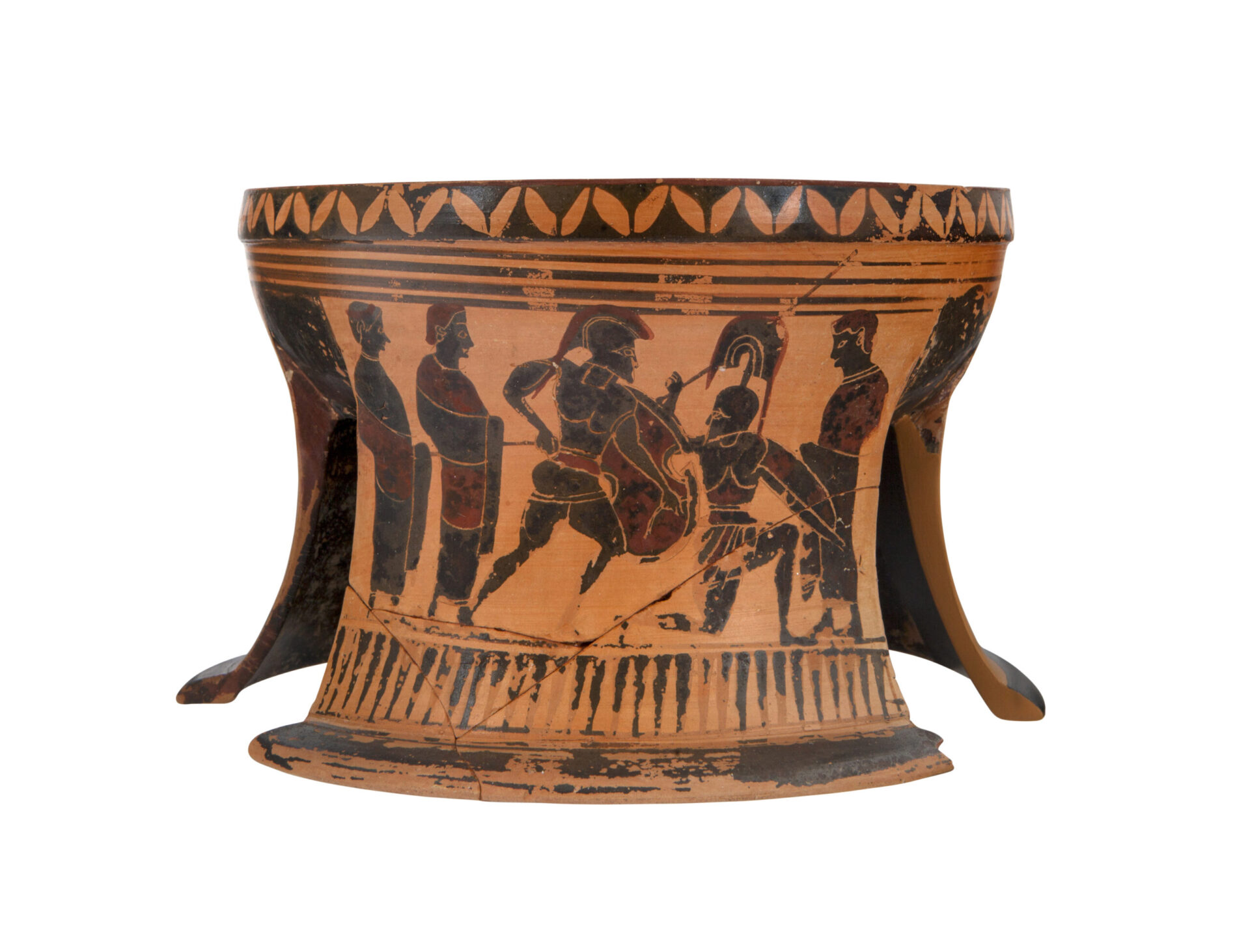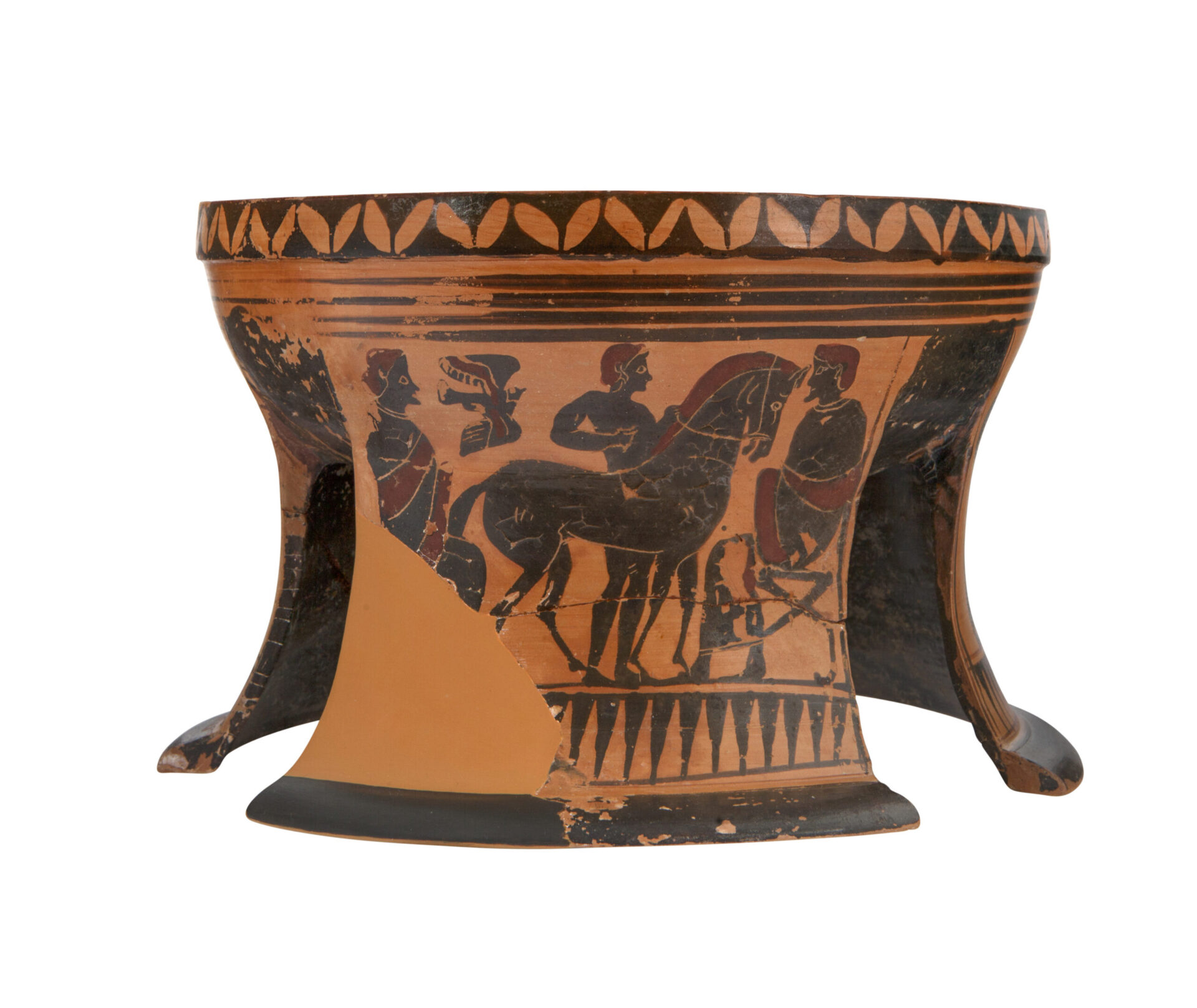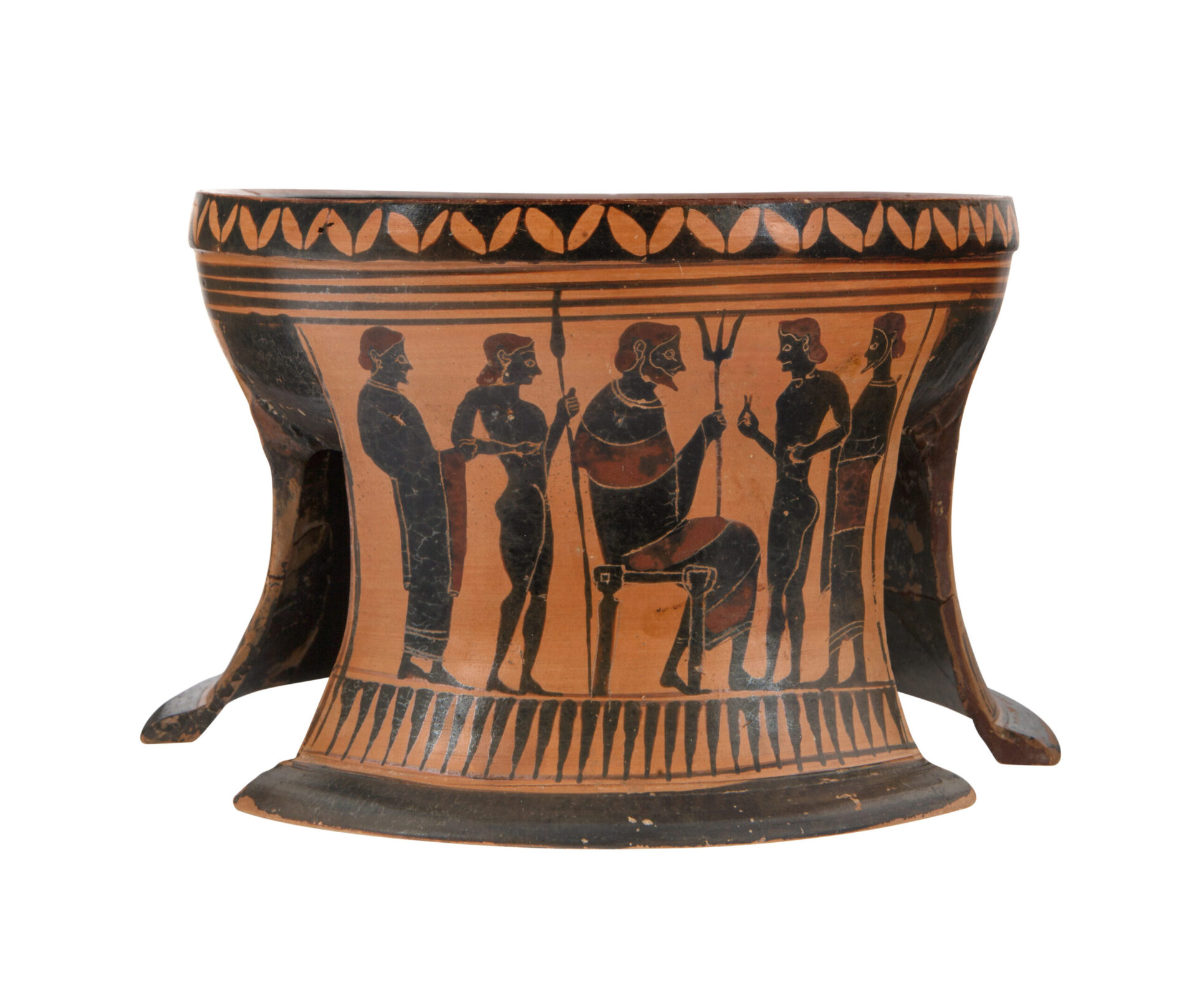Exhibit of the month
Ηippios Kolonos: Cultic rituals in the sacred place of Poseidon
Attic black-figure tripod pyxis
Hellenic National Archaeological Museum
Vase Collection, inv. no. 407
Provenance: Archaeological Society at Tanagra excavations. Excavated by P. Stamatakis in 1881.
Dimensions: Height 13,4 cm., diam. rim. 19,9 cm., width of foot, 14-16 cm.
Date: 550- 540 BC.
Display location: Room 53, Showcase 64
On one of the three feet of the pyxis[1] a bearded Poseidon is seated on a stool with a trident in his left hand. On either side of the god stand two naked youths and immediately behind them two bearded himation-glad men. The youth in front of Poseidon is holding a flower in his right hand, while the youth behind him holds a spear in his left hand.
The second foot of the vase is decorated with hoplite duel[2]. The defeated warrior, kneels on his left leg, head turned to his opponent, with his hand holding the spear out behind him, in an attempt to evade the final blow. On the third foot a naked youth with short hair is depicted leading a horse by its reins[3]. On either side of this figure are seated bearded figures wrapped in long himatia. Behind the horseman’s head a bird flies towards the same direction.
The three iconographic themes of the pyxis, albeit different, and not part of the same narrative could still be associated with the cult of Poseidon at Hippios Kolonos in Athens. His divine presence and prestige are indicated by exaggerating his size in comparison to the other figures and his depiction in the centre of the composition.
The scene on the pyxis shoud be included to themes which promote the prestige of the honoured deity and must be associated with a particular sanctuary or festival of the god in Attica, even though there are no elements in the depiction that could reveal the exact location of the shrine or the character of the god. Other than the sanctuary of the god at Sounion and his cult in the Erechtheion, Poseidon was the patron deity of the Athenian cavalry and of the horses which belonged to the aristocratic class, and was worshipped as “Hippios” at Hippios Kolonos in Athens jointly with Athena Hippia. At Hippios Kolonos, the sacred place of Poseidon, various historical events took place and various cults and myths coexisted[4]. An important aspect of military life in Athens was connected to the worship of the god at Hippios Kolonos, This fits the iconography of this pyxis. The scene of hoplite duel could be linked with the tradition that at Kolonos Poseidon mated with a ‘wild female creature called Gorgo-Medusa, who when he was beheaded by Perseus, a horse and armed warrior (Pegasus and Chryssaor) emerged. The naked youth with the horse on the other foot might be relevant, if one takes into account the information concerning chariot races held in honour of Poseidon in different parts of Greece and testimony that characterizes him as inventor of cavalry, horse tamer but also guarantor of political order. Moreover, the Sacred Grove of Poseidon was the locale where the suitability test of horses and chariots before the race took place, a ritual to gain the favour and the refinement of the god.
Finally, according to Sophocles (Oedipus at Kolonos, v. 1590-1594), at Hippios Kolonos there was a chasm of land leading to the Underworld and Poseidon, in his chthonic substance, was providing the entrance to Hades.
[1] The pyxis, a small container with lid, was used to keeping ointments and medicine preparations, quite often was also part of a woman’s personal belongings in which she placed jewellery and cosmetics. The type of tripod pyxis first appeared in Corinth and was adopted in Attica during the first quarter of the 6th century BC and went out of fashion in the early 5th century BC.
[2] The iconographic prototype for these scenes seems to be the epic fight between Achilles and Memnon over the body of Antilochos, or that of Achilles with Hector over Patroclo’s body.
[3] The theme of horsemen, either mounted or standing beside a horse is common in black-figure vase painting in the 6th century BC. Usually, the figures of horsemen are interpreted as aristocrats engaged in activities which are associated with hunting and equestrian competitions.
[4] The tragedy of Sophocles, Oedipus at Kolonos, took place in Kolonos, while there are testimonies (Pausanias, I,30.4) of a heroon of Theseus and the worship of Prometheus, Demeter, Dionysus and Kolonos. Also, in 411 B.C. the oligarchs convened the church of the demos at the sanctuary of the god to abolish democracy, while in 407 B.C. the Athenians succeeded in driving the Spartan Agis from the area with their cavalry.
Dr Evangelos Vivliodetis
BIBLIOGRAPHY
For the use and for the types of pyxides:
Ε. Vivliodetis, CVA Athens National Archaeological Museum 8. Attic Black and Red Figure Pyxides, Athens 2019. S. Schmidt, Between Toy Box and Wedding Gift: Functions and Images of Athenian Pyxides, Mètis n.s.7 (2009) 111-130
For the worship of Poseidon in Attica:
A. Shapiro, Art and Cult under the Tyrants in Athens (1989) 101-108; LIMC VII (1994) s.v. Poseidon, 447, 448 [E. Simon] P. Siewert, Poseidon Hippios am Kolonos und die athenischen Hippeis, in G.W. Bowersock et. al. (eds.) Arktouros. Hellenic Studies presented to B.M.W. Knox on the occasion of his 65 th birthday (1979) 280-289.
For the worship of other deities at Kolonos and the historical events that took place in this area:
Α.Αβραμίδου, Εικονογραφικές παρατηρήσεις σε έναν ερυθρόμορφο κρατήρα από την Όλυνθο: θεατρικές παραστάσεις, στο Ε. Κεφαλίδου – Δ. Τσιαφάκη (eds.) Κεραμέως παίδες. Αντίδωρο στον Καθηγητή Μιχάλη Τιβέριο από τους μαθητές του, Θεσσαλονίκη 2012, 135-142.
On the relationship of the god with horses and the rituals in the groves of Poseidon concerning the suitability test of horses and chariots:
W. Burkert, Griechische Religion der archaischen und klassischen Epoche (Greek translation.Ν. Μπεζαντάκος-Α. Αβαγιανού,1993) 296-297. Ε. Μανακίδου, Παραστάσεις με άρματα (8ος-5ος αι. π.Χ.) Παρατηρήσεις στην εικονογραφία τους, Θεσσαλονίκη 1994, 46-47.





